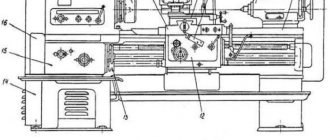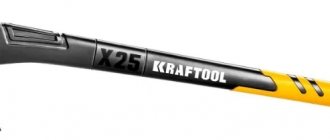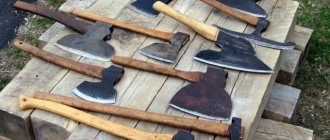Hello everyone, today we will make such a useful thing for the kitchen as a kitchen hatchet. Using this homemade product, you can chop or cut vegetables, meat, bones and other products. The author used an old saw blade made of thick steel as the material. As a result, the hatchet became weighty, which makes it convenient. The product was also quenched and tempered, which made the steel durable. The handle covers are made of wood, which is impregnated with epoxy resin; as a result, such a handle will not be afraid of water. The only drawback of the chosen steel is that it rusts, but if the ax is used often, over time the steel will become covered with a patina. You can make the patina yourself, using etching and so on. If the homemade product interests you, I suggest you study the project in more detail!
Materials and tools used by the author:
List of materials:
– old saw blade (made of good steel); – wood for linings; – brass rods for pins; – epoxy resin and dye; – wood oil.
The process of making a hatchet:
Step one. Ax profile
Before cutting an axe, it is advisable to check the steel for hardening. Otherwise, it can be very disappointing later when the product suddenly refuses to harden. To save steel, some modern saw blades are made from poor metal; such “steel” cannot be hardened.
The author uses an old thick saw blade as the starting material. First, draw the desired profile of the hatchet on it with a pencil, and then draw it with a marker. That's all, you can start cutting, the author works with a grinder. Our metal is quite thick, so cutting will take quite a long time. As for problem areas that cannot be cut out with a grinder, we cut them out in pieces.
Step three. Heat treatment
Let's start hardening the axe; to do this, the steel needs to be heated to a temperature of just over 800°C. The ax should warm up evenly; it will glow in all places with the same red hue. Next, immerse the ax in oil and check whether the hardening was successful. If everything is done correctly and the ax is made of quality steel, it should not be scratched by a file.
Then be sure to temper, otherwise the steel will be very brittle and the blade may chip. For holidays we use the oven, the temperature is classically set at around 200°C. If the steel has been pre-ground, it will turn straw-colored after tempering.
Step four. Grinding
After hardening, the steel will be covered in soot and scale; the whole thing needs to be cleaned off. We arm ourselves with an orbital sander and polish the hatchet well until it shines.
As for the slopes, the author decided to polish them by hand. We use fine sandpaper and WD-40. If desired, the slopes can also be polished.
Step five. Overlays
We make linings for the handle, here we need wood, a block or a thick board will do. As a decoration, we drill holes in the workpiece and fill it with epoxy resin and dye. The author used a silicone mold to pour the resin.
Kitchen hatchet made from a saw blade
Hello everyone, today we will make such a useful thing for the kitchen as a kitchen hatchet.
Using this homemade product, you can chop or cut vegetables, meat, bones and other products. The author used an old saw blade made of thick steel as the material. As a result, the hatchet became weighty, which makes it convenient. The product was also quenched and tempered, which made the steel durable. The handle covers are made of wood, which is impregnated with epoxy resin; as a result, such a handle will not be afraid of water. The only drawback of the chosen steel is that it rusts, but if the ax is used often, over time the steel will become covered with a patina. You can make the patina yourself, using etching and so on. If the homemade product interests you, I suggest you study the project in more detail! Materials and tools used by the author:
List of materials:
- old saw blade (made of good steel); - wood for linings; — brass rods for pins; — epoxy resin and dye; - wood oil.
The process of making a hatchet:
Step one. Ax profile
Before cutting an axe, it is advisable to check the steel for hardening. Otherwise, it can be very disappointing later when the product suddenly refuses to harden. To save steel, some modern saw blades are made from poor metal; such “steel” cannot be hardened.
The author uses an old thick saw blade as the starting material. First, draw the desired profile of the hatchet on it with a pencil, and then draw it with a marker. That's all, you can start cutting, the author works with a grinder. Our metal is quite thick, so cutting will take quite a long time. As for problem areas that cannot be cut out with a grinder, we cut them out in pieces.
Step three. Heat treatment
Let's start hardening the axe; to do this, the steel needs to be heated to a temperature of just over 800°C. The ax should warm up evenly; it will glow in all places with the same red hue. Next, immerse the ax in oil and check whether the hardening was successful. If everything is done correctly and the ax is made of quality steel, it should not be scratched by a file.
Then be sure to temper, otherwise the steel will be very brittle and the blade may chip. For holidays we use the oven, the temperature is classically set at around 200°C. If the steel has been pre-ground, it will turn straw-colored after tempering.
Step four. Grinding
After hardening, the steel will be covered in soot and scale; the whole thing needs to be cleaned off. We arm ourselves with an orbital sander and polish the hatchet well until it shines.
As for the slopes, the author decided to polish them by hand. We use fine sandpaper and WD-40. If desired, the slopes can also be polished.
Step five. Overlays
We make linings for the handle, here we need wood, a block or a thick board will do. As a decoration, we drill holes in the workpiece and fill it with epoxy resin and dye. The author used a silicone mold to pour the resin.
When the epoxy resin dries, we need to cut the workpiece lengthwise to create two halves, which will become the overlays. For cutting, the author uses a band saw, but you can also do it with a hacksaw. We grind the workpieces well and you can cut out the primary profile.
Step six. Installation of overlays and completion
We cut brass rods that will be pins, and also mix epoxy glue. We glue the handle, not forgetting to thoroughly coat the pins with glue. We tighten everything well with clamps and let the glue dry.
Well, when the glue dries, we set the desired handle profile; the author carries out this work manually, so as not to remove excess. First we work with files, and then we switch to sandpaper and grind the handle until it is perfectly smooth. Finally, we coat the handle with oil or varnish, this will return the epoxy resin to its former transparency, and the handle will look like a masterpiece.
Correct tool sharpening technology
The technology for sharpening a professional meat ax is practically no different from a similar procedure for other piercing and cutting tools (Figure 5).
To carry out the procedure correctly, you must consider the following:
- The work area must be properly equipped. The sharpening tool must be firmly installed on the bed, and the bed must be attached to the floor so that it does not move during operation.
- Before starting work, carefully inspect the abrasive wheel: it must be absolutely smooth, without beating or nicks. Only in this case will you be able to sharpen it technologically correctly and without harm to the blade.
- Take care of personal protective equipment as well. First of all, you need to put on safety glasses. Kitchen hatchets are made of high-quality steel, and during the sharpening process, metal splashes and abrasive dust can fly in all directions and accidentally get into your eyes.
- The sharpening technology itself is as follows: the blade is held in the direction “away from you” towards the rotation of the circle and parallel to its axis. It is advisable to hold the ax with both hands so that you can accurately maintain the sharpening angle.
- During the process, try not to overheat the cutting edge. As a result, the steel of the blade may become too brittle and will crumble during further use.
Figure 5. Correct sharpening technology
If during sharpening you notice that a burr has accidentally formed on the blade, do not despair. This does not mean that the instrument is damaged. To correct the situation, simply turn the ax over and start sharpening it in the other direction. It is better to bring the cutting edge to the desired condition on a small abrasive wheel
At this stage, extreme care must be taken so that the edge of the chip does not break off, and the edge itself remains strong. To do this, it is best to use the double sharpening method.
At the final stage, you can check the sharpening angle of the blade using special templates and, if necessary, bring the product to perfection.
What types of axes are there?
The ax dates back to BC. But people still use it, no longer as a weapon, but as an everyday tool. Today there are even several varieties of this instrument. It is used for a variety of needs. You can purchase it in a special store or create it yourself. Materials will be required of high quality and reliable.
But first, it’s worth taking a closer look at the types of axes:
- combat - refers to a type of edged weapon. These days you can only buy them as a collector's item;
- taiga - since it has to be used in rather harsh conditions, this type of ax differs in its parameters and even shape from any other;
- tourist - a brand new camping ax has a small length and weight: 35 centimeters and half a kilo, respectively. Suitable for simple work;
- household - mainly used for chopping firewood. Its blade is made of hardened steel and its handle is made of suitable wood. This is easy and comfortable to use.
Recommendations for selection
According to experts, when choosing an ax for cutting meat, you should take into account some nuances
Blade Specifications
This detail is the most important in the entire design; a good blade will be thick and weighty. It is precisely these properties of the metal element that determine the classification of this device into the category of hatchets, since it is the balance between the mass and thickness of the metal that will be responsible for the chopping capabilities of the tool
As for the shape, it can be straight or rounded.
Product handle configuration
The optimal size of the handle will be the ability to operate the tool with one hand, that is, its length should be within the palm of your hand. In addition, it is best that it has a rounded shape with special recesses for a comfortable location of all fingers. This way the tool will not slip out while cutting meat.
Cutting edge type
The classic sharpening option is not suitable for an axe, since it is important that the edge remains sharp in working condition on each side. This feature will greatly facilitate the further operation and maintenance of the ax due to the fact that this type of product is the easiest to sharpen by choosing the correct sharpening angle
The optimal angle would be 40 degrees. This product will allow the tool to cut fibers and bones as deeply as possible.
Type of steel used
As a rule, certified products, unlike products made by handicraft, will have a special mark on the head of the tool. Such an abbreviation will contain data about the grade of steel used to produce the ax.
It is important to pay attention to the fact that it should be in the area where the handle comes into contact with the cutting part
Additional configuration details
Good and high-quality products should have a special eyelet on the body, which will allow you to properly store the equipment after use.
Place of purchase and cost
Often the cost of the same product will differ significantly when comparing the pricing policies of supermarkets and markets. Therefore, you can safely purchase kitchen tools at retail outlets, which will save money, however, this will not in any way affect the quality of the purchased product. Also, for rare use of an ax, buying an expensive tool is simply pointless. Today, inventory from domestic and foreign brands is on sale, which, for the most part, have high quality indicators for the products sold.
Ease of use
It is best to select kitchen or professional tools yourself. Before purchasing, you should definitely test the cleaver, hold it in your hands, evaluate the comfort of the handle, weight and other characteristics of the product you like. Otherwise, there is a risk that even a high-quality and attractive tool will simply be unsuitable for a cook, butcher or housewife.
Materials and tools for work
To create an ax similar to the one used by real Vikings, you will need the following materials:
paper;
A properly selected handle should not subsequently become loose during the drying process if the degree of humidity in the environment changes. If such a need arises, the workpiece must be dried in warm and dry conditions.
The following breeds are best suited for making an ax handle:
- beech - has all the necessary qualities, but also has a disadvantage - it absorbs moisture from the air. Therefore, before you start making the handle, you need to further process it;
- oak is a hard, durable and very durable species;
- maple is a very elastic and durable material. The finished handle will have a beautiful texture;
- ash is the best option, since this particular species is known for its strength, durability, and most importantly, affordability. The handle will turn out very beautiful.
The following tools will be required for the job:
- welding machine;
- drill;
- Bulgarian;
- grinding machine.
Having decided on the materials and prepared the tools, you can begin to create a Viking ax.
Work process
All work will take place in several stages. Since the Viking ax will be made from an old axe, the essence of the whole process will be the restoration and stylization of the instrument.
cloth
- It is necessary to separate the panel from the handle.
If there is rust, clean it with a grinder and then remove the scale.
Then process the resulting cut on a grinding machine.
Work with the panel is completed.
Metal hardening
This procedure also consists of several parts at once:
- Annealing. First of all, you should dull the edge of the blade by a millimeter. To do this, you need to heat it to about 760 degrees (the metal will acquire a red-burgundy hue) and then slowly cool it. Then remove the scale.
Hardening. You need to heat the blade to 830 degrees and prepare two metal buckets - one should contain just warm water, the other should contain oil. The blade should be lowered into the water for just a couple of seconds and only about 4 cm. And then completely into the oil. It is important not to forget about safety when working with fire.
Vacation. This stage is important for strengthening the steel. The blade must be cleaned. Vacation should be carried out for an hour at a temperature of approximately 200-300 degrees. Can be done in a regular home oven.
Details of the hardening procedure can be found in the video.
Handle (axe)
- Plane a simple ax handle from a block.
To decorate it, you can choose any Celtic ornament you like, transfer the drawing with a pencil to the wood and then develop it using a drill.
To protect the handle from moisture, you need to coat the wood with varnish. As an alternative, you can use flaxseed oil.
Now you can connect the handle to the blade and drive in the pre-prepared wedge.
Braid for ax handle
When the ax itself is ready, all that remains is to make a convenient braid for the handle. It will perform not only protective, but also decorative functions.
How to make a braid:
- Cut a rectangular piece from leather (or leatherette).
Characteristics
The functions of a kitchen meat hatchet are inherent in the very name of the tool. The product does not cut, but rather chops without destroying the connective fibers of the fabric - this is facilitated by the width of the blade and increased weight. The balanced shape and minimal thickness of the metal prevent bones from crumbling and cracks from forming. In operation, such axes are much more ergonomic than knives, which can also be used to chop meat, with some effort. The efficiency of the product is high, and the user’s hand does not get tired.
Material
To create a butcher's hatchet, metal is used that is resistant to corrosion and scratches. Companies often produce tools from alloy steel grades X12MF, AUS-8, VG-10, which are best suited for this purpose. The advantage of this material is its long service life. If nicks and scratches appear on the blade, it becomes more difficult to work with - in this case, immediate grinding and sharpening is required.
Blade size and shape
A meat cleaver can have different shapes, so the choice of the right type will depend on the purpose of use. To work without extra effort, you should give preference to a product with a very wide blade and a slightly convex shape of the cutting side. This will make the process of splitting bones much easier. The described shape allows the ax to penetrate the meat at an acute angle. The blade is usually made elongated so that a larger area of the carcass is captured. The optimal blade size in a kitchen hatchet for chopping meat is considered to be 135-180 mm.
Sharpening
The sharpening angle of the tool is of great importance. It is desirable that it be within 25-30 degrees. The sharpening should not be an even cone, but rather have a slightly rounded shape, with a slight acute angle. This will make it easier for the metal to penetrate the product - even with a slightly dull blade, the bones will break without problems and the meat will be cut quickly.
It is important that sharpening is carried out according to all the rules, then the cutting process will be easy and safe. In specialized workshops, all manipulations take no more than half an hour.
You can make the blade sharp yourself. One of the important aspects of such work is a correctly formed chamfer. The process is carried out in several stages. The best material for this purpose is a ceramic musat (has some similarities with a file), which is a rod with a handle with an oval or round cross-section. For sharpening, you can use a diamond stone or a sharpening wheel.
DIY kitchen hatchet drawings
It's no secret that an ax is an indispensable carpentry tool. In addition, the ax is especially useful in the household: from chopping wood to home repairs.
This article examines issues related to the manufacture of a taiga-type axe, because finding such a useful tool on the market is quite difficult, and it will cost a lot. The article provides additional useful information that will tell you which ax is best to choose for certain needs.
Brief contents of the article:
What should a taiga ax be like?
Such an ax, thanks to its special parameters, which are radically different from the characteristics and sizes of “classic” axes, is an indispensable assistant when performing many tasks, such as:
- Tree cutting. Whether it’s carpentry work or simply preparing firewood for the winter, a taiga ax will help you complete the task quickly and efficiently;
- A tool as a way of “survival” - any catalog of axes will confirm the statement that the taiga ax is ideal for hunting, preparing bags and traps;
- Creation of a hut and flooring, construction of a wooden house in the shortest possible time;
- Preparation of firewood.
Rough processing of logs – removal of branches, other similar work;
In cases where the work requires special precision, the best option is a forged ax with a long blade. Cutting down trees with such an ax is not very effective, but accuracy plays an important role.
Distinctive features of the taiga type ax
Most people do not see the difference between a taiga and an ordinary ax at all. So what are the differences between these two types of axes?
- The length of the roundness of the blade means that the taiga ax is lighter in weight;
- A long beard provides additional protection against deformation and breaking. Typically absorbs up to 60% of impact force;
- Special sharpening - allows you to use the ax as a standard cleaver, when choosing the right blow. In this case, the leading edge of the blade is twice as wide as the rear. The edge of a regular ax has the same thickness;
- A special angle of inclination of the ax reduces hand fatigue and increases the overall efficiency during work.
Varieties
A kitchen hatchet is somewhat different from a regular axe. Products intended for home use look less bulky and are more comfortable. A regular ax consists of a wooden handle and a metal blade. Its kitchen counterpart has a one-piece design, thanks to which the hatchet does not slip during operation, and the center of gravity is located exactly in the middle: between the butt and the tip.
Hammer-hatchet for processing meat
Almost no kitchen can do without this tool. Such products were often found on the farm during the USSR. In addition to chopping, you can also chop prepared pieces of meat with such a hatchet. To keep the room clean, it is recommended to wrap the meat in cling film.
Uzbek hatchet
Some dishes prepared from meat with your own hands require that it have the consistency not of minced meat, but of finely chopped pieces using a knife. This meat is used for chebureks, manti, samsa, lula kebab and other oriental dishes. In this case, a specially shaped hatchet comes in handy, which allows you not to cut by pressing, but to chop, and the juice does not leak out.
Kitchen hatchets can be washed in the dishwasher, but experts advise using predominantly hand washing so as not to quickly dull the blade. Like any kitchen knives, the hatchet will need periodic sharpening.
Making a taiga ax head
It is worth purchasing an ordinary carpenter's ax, the head of which will weigh 1400-1500 grams.
From the front we cut off the protrusion of the blade flush with the butt. We form the roundness of the back of the blade - the grinder will help us with this. It is necessary to cut off all the metal so that there are no corners left.
We move on to the inside of the blade - carefully cut out a semicircle, which is necessary for a more comfortable grip. In addition, this manipulation can significantly reduce the weight of the head. To further reduce the weight and increase the maneuverability of the ax, it is necessary to saw off the upper corners of the butt.
Sharpening is done using an emery machine. For best results, install a large circle with medium grain. In addition, sharpening should be done on both sides.
Varieties
Differences in tool configuration allowed axes to be classified
Sharpening circular saws for wood with your own hands: geometry of corners, machines
Taking into account the type of blade, they are:
- professional cleavers with a wide cutting area;
- tools with medium blade width;
- axes with a small cutting element.
An ax knife for a butcher will be quite weighty, as a rule, its weight is about 3 kilograms. Also on sale you can find a multifunctional version of a kitchen tool for meat - a hammer-axe, which can perform several tasks at once. This product is not heavy, so it is suitable for use by housewives.
In addition, axes for processing meat products can be classified by taking into account the type of handle with which the tool is equipped. Most often, wood that is familiar to everyone is used for the handle; however, modern products for professional and household use mostly have rubber or plastic handles that prevent the hatchet from slipping in the hand.
Making an ax handle for a taiga ax
It is worth noting that choosing the right wood is the key to success in making a high-quality taiga ax. Ideal options would be maple and ash. Simpler options are birch and pine. The latter is perfectly polished and sharpened, but is extremely unreliable due to its fragility.
Below are the instructions:
Selection of lumps - without knots or defects. Processing and drying - the tree is cleared of bark and split in the middle. Wood should be dried at +25°, with a humidity level of 15%. Aging lasts two months.
Creating a mold - we will need a hatchet or a large knife to remove the main wood. In addition, do not forget about a chisel and a small hammer - these tools will be needed for smaller jobs.
How to mount an ax? You should use gauze and epoxy resin. After three days, the taiga ax will be ready for use.
The last step is sanding and varnishing. The ax will become not only useful, but also beautiful, like in the photo from the advertising catalogue!











